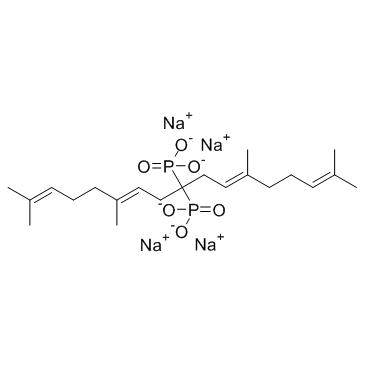Digeranyl bisphophonate
Modify Date: 2025-08-25 10:22:42

Digeranyl bisphophonate structure
|
Common Name | Digeranyl bisphophonate | ||
|---|---|---|---|---|
| CAS Number | 878143-03-4 | Molecular Weight | 536.4 | |
| Density | N/A | Boiling Point | N/A | |
| Molecular Formula | C21H34Na4O6P2 | Melting Point | N/A | |
| MSDS | N/A | Flash Point | N/A | |
Use of Digeranyl bisphophonateDigeranyl bisphophonate is a potent geranylgeranylpyrophosphate (GGPP) synthase inhibitor, which inhibits geranylgeranylation of Rac1. |
| Name | Digeranyl bisphophonate |
|---|
| Description | Digeranyl bisphophonate is a potent geranylgeranylpyrophosphate (GGPP) synthase inhibitor, which inhibits geranylgeranylation of Rac1. |
|---|---|
| Related Catalog | |
| Target |
Rac1[1] |
| In Vitro | Digeranyl bisphosphonate (DGBP) impairs geranylgeranylation. To examine if Digeranyl bisphosphonate modulates Rac1 activity, cells are exposed to vehicle or Digeranyl bisphosphonate. Rac1 activation increases significantly after chrysotile exposure, whereas the activity in Digeranyl bisphosphonate -treated cells is reduced to control levels. Digeranyl bisphosphonate also decreases H2O2 generation in chrysotile-exposed macrophages[1]. |
| In Vivo | To further evaluate the effect of Digeranyl bisphosphonate (0.2 mg/kg/day) in protecting mice from chrysotile-induced pulmonary fibrosis, the mice are administered vehicle or Digeranyl bisphosphonate subcutaneously in osmotic pumps, and exposed to saline or chrysotile the following day. Mice exposed to saline have normal lung architecture with vehicle and Digeranyl bisphosphonate treatment. Chrysotile-exposed mice that receive vehicle have significant architectural changes in their lung parenchyma and large amounts of collagen deposition, whereas the lungs of the Digeranyl bisphosphonate -treated mice are essentially normal. To investigate the effect of Digeranyl bisphosphonate in Bleomycin-induced fibrosis, osmotic pumps containing either vehicle or Digeranyl bisphosphonate are implanted subcutaneously in WT mice. Mice are exposed to saline or Bleomycin the following day. Digeranyl bisphophonate (0.2 mg/kg/day)-treated mice show significantly less hydroxyproline compared to vehicle-treated mice exposed to Bleomycin[1]. |
| Kinase Assay | Rac1 and Rac2 activity are determined using a bead pull-down kit or Rac1 activity is determined using the G-LISA kit. Negative and positive lysate controls are incubated with GTPγS or GDP, respectively, during PAK-binding domain-GST pull-down for Rac1 and Rac2. Bound protein is eluted and separated by SDS-PAGE. Immunoblots are probed with an antibody specific to Rac1 or Rac2, and GST expression is determined by Coomassie staining, as a loading control. Active Rac1 is also determined by the binding of Rac1 to PAK-PBD beads immobilized in a 96-well plate using G-LISA. The bound active Rac1 is detected with a Rac1 specific antibody. Absorbance is read at 490 nm and normalized to protein concentration in the lysate sample[1]. |
| Animal Admin | Mice[1] Wild-type C57Bl/6 mice are used. After equilibration, osmotic pumps containing either vehicle (water) or Digeranyl bisphosphonate (0.2 mg/kg/day) are implanted subcutaneously. Rac1 null and Rac2 knockout mice are used. Briefly, Rac1 null mice are conditional and are generated using LysMcre to selectively delete Rac1 from cells of the granulocyte/monocyte lineage. The Rac2 knockout mice are generated using conventional gene targeting to delete the Rac2 gene as Rac2 is only expressed in cells of the granulocyte/monocyte lineage. Bleomycin (1.3-2.0 U/kg) or Chrysotile (100 μg) is administered intratracheally. Mice are euthanized and fibrosis determined. |
| References |
| Molecular Formula | C21H34Na4O6P2 |
|---|---|
| Molecular Weight | 536.4 |